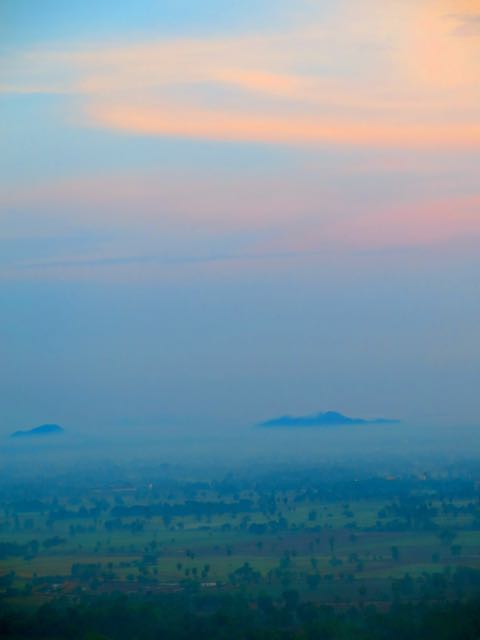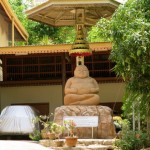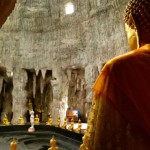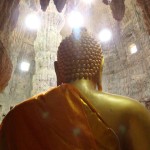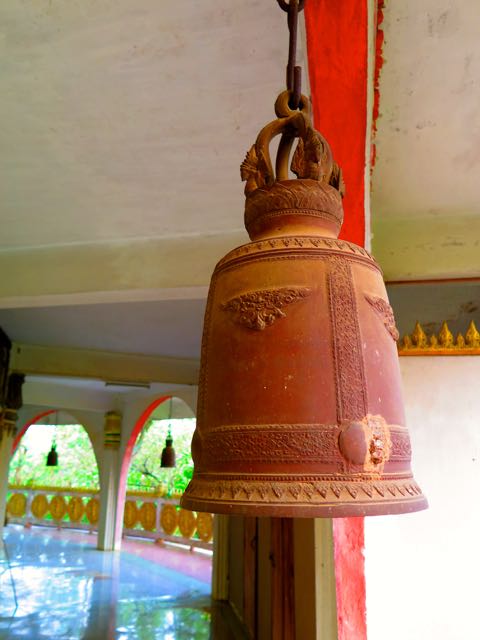
At 3 AM, a gong reverberates us awake — time for morning chanting and meditation. I place my cushion behind everyone else’s so that they will not notice my frequent fidgeting. In the morning, I do better than in the evening, but seriously, the lotus position is painful. I hope that with time my limbs and body will accustom to five daily hours of it.
After morning meditation, the monks converge in the level below the temple where the novices and I sleep. There is a bustling of gathering their alms bowls. I am lost unaware of what I should do until Mott asks in English, “Would you like to come with us?” He quickly adds, “or not if you don’t want to,” and I realize that this is his extremely passive way of saying, “you really ought to come with us.”
The monks separate into groups, some boarding a bus to go to more distant villages and Mott, Ess, Nam, and I walking to the nearest village of Ba-liet, a name I remember by mnemonically associating it with Bud Light.
We walk in darkness in the coolness of the 70° morning. Ess and Nam silent in front in their paprika colored robes and Mott and I a few steps behind in our white garbs, called pacow, which means pure. I tell Mott that his name means ‘word’ in French and this causes a smile to erupt across his face as he learns something new about the oldest thing he knows.
Being Part of Bintabot
We have set out for “bintabot,” or to ask for alms. Thai Buddhists belong to the Theravada tradition, which avails to the Pali Canon, in which monks must not have money or engage in commerce. The morning meal they eat every day must come from donations given that morning. There is a story in the Pali Canon where a king asks The Buddha what is the fruit of an ascetic’s labor. His answer is that in receiving, the ascetic teaches people to give.
The surrounding hills and fields around Khao Sarapatdi are everything you imagine Asia to be. A sea green river snakes through polygon plots of rice patties, each a different shade of straw. Trees bunch together like bands of brothers and some stand in single file lines of departure from these clumps, as if showing the way to somewhere else. Birds of every range of note have too much to say and never grow tired of tweeting it. As if built to mimic the meandering of the river, a ochre dirt road weaves to the horizon then disappears indiscriminately into a permanent curtain of humidity born vapor that from one perspective enfolds the world and from another connects it to an unbounded sky.
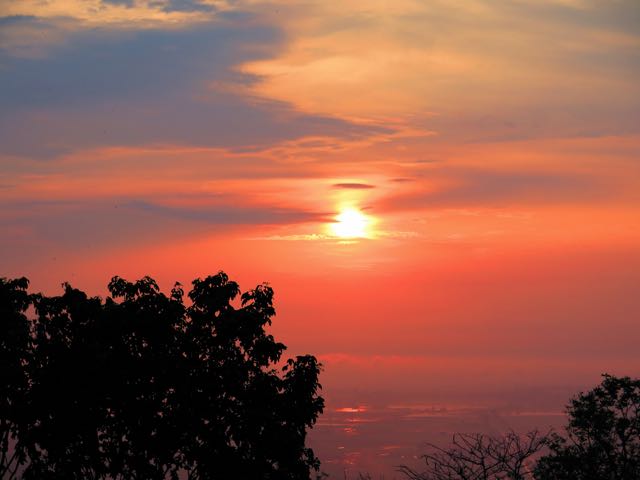
How to describe it all? I spend nearly every morning soaking up the walk and writing seems such an imperfect medium for sharing it. There is the slow stridulation of insects exhausted from their dusk till dawn performance. There is the crescendoing choir of morning insects just waking up to fiddle up the sun. There are roosters trying to outdo each other, each seeming to call, “WHO’S A ROOSTER?! WHO’S A ROOSTER?!” There are birds partial to quarter notes, birdS drawing out long trailing notes, eighth note birds, half note trilling birds, birds all over the scale, and birds who seem to sarcastically squawk, “Oh wow! Oh wow! Oh wow!”
The road is misty, like it’s hiding something from the dawn as the horizon hints at the kaleidoscope of still-concealed colors. Every breath here is a smell that takes you to a million other places. The air is thick with the aroma of a commercial greenhouse, a tomato leaf from your dad’s garden, blue fruit roll-ups, rural Vermont on a June morning, the
frog pond of your youth—it’s all here, floating in the breezes.
Along the way, Mott teaches me more words in Thai—wall, street, and tree.
When we reach the dirt road that leads to the village, the smell of cattle overpowers everything else. The road is flanked by banana trees in danger of coconuts falling from above. Distant palms are still shrouded in morning mist and a flock of birds flies past a now neon horizon. You can’t describe the horizon as a single color, couldn’t even capture it with a camera because it’s a living transformation of yellows atop orange, under blues, over satin whites, lightening, lingering, then darkening, only to lighten again.
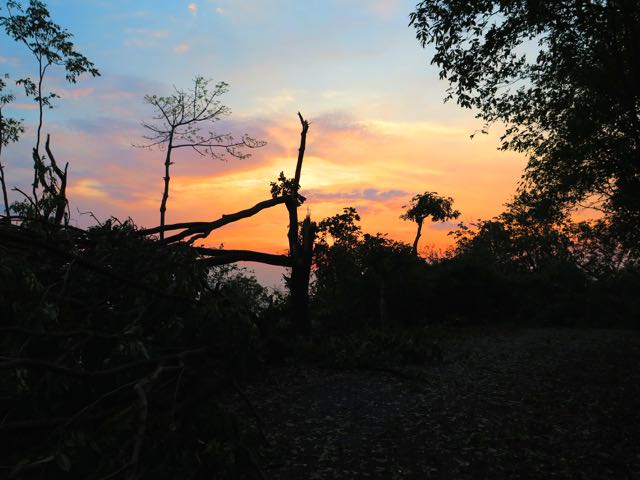
I’m not sure what I was expecting once we reach the village, but I’m not prepared for the experience that unfolds. I think my rough estimation was that we’d sit out in the village’s Central Square and hold out our bowls for alms.
But it’s a door to door deal. The village is prepared for us, and we stop at every single household where a man, or woman, or two women, or mother and child, or a boy, or twin sisters and their mother, or a father and his daughter, come out to greet us, remove their sandals, bow to the monks, and spoon rice into the monk’s bintabot bowl while giving a bag of cooked food or fruit into the bowl’s cover that Mott or I then retrieve and place into the shoulder bags we’ve been given for the outing.
Academically, I guess I knew that this still went on in the world, but seeing it, the village’s devotion to their monks and the humility and gratitude they have at being able to give, and not being just an observer but one of the recipients receiving a good meal from people most in the West consider poor people, is a moment I know I am very lucky to have. I bow to each alms giver, clearing my mind of everything to make room for only gratitude.
Gratitude At Being Able To Give
We walk from house to house, at each a moving scene of giving and gratitude at being able to give. We walk trails that cut through bamboo forests to the village’s outskirts, dogs lose their shit and run to us with warm greetings or gnarled warnings. A few villagers comment about the presence of a Farang as a novice, but most seem not to notice and offer their edible alms, then bow as the monks receive in silence what is given to them. One woman who owns four dogs and six cats speaks about me in the tone reserved for puppies and babies and asks the monks if she may give me a mango.
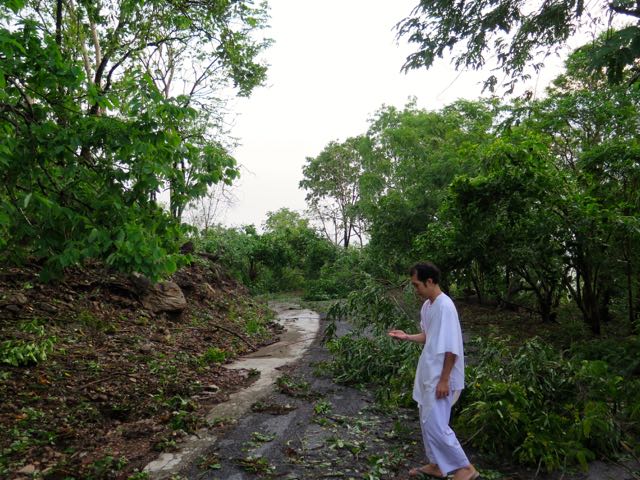
Mott
On the walk back to the temple, Mott tells me a bit about his life. He has worked “many jobs,” but at 32 has decided he is done with that, that working as he has done is empty. Over the last year he has walked over 1000 km from temple to temple across Thailand. At some he stays several months, others only a few nights. When he set out he was joined by a monk who was wandering from temple to temple, collecting different lessons from various teachers.
Sometimes he sleeps in the forest. “It’s very free,” he says, “to be able to go wherever you want, where in every temple you can have a place to sleep and something to eat and a lesson to learn.”
Read more from my series, “Being Buddhist in Thailand”

